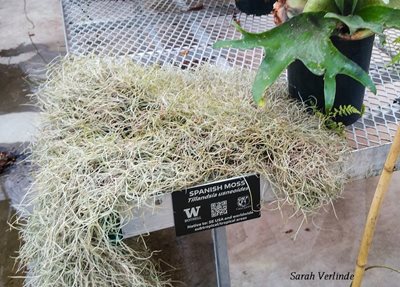Spanish moss
Tillandsia usneoides – Spanish moss
Family: Bromeliaceae
Other common names: Graybeard, long moss, Florida moss
Morphology

Perennial, epiphytic herb. Epiphytes are commonly called “air plants” because they grow on things (trees, branches, stone walls) and do not need soil. Spanish moss grows in long thick garlands with slender, branching stems, up to 24 feet long. The silver-gray scales that cover the leaves and stems can trap moisture, dust, and detritus which helps the plant collect nutrients, like nitrogen.
Did you notice the common names refer to moss? The Latin species name “usneoides” refers to Usnea – a genus of a hanging gray-green lichen. This plant is neither a moss nor a lichen. It’s a flowering plant, related to pineapples and showy bromeliads!
Distribution/Habitat
High humidity areas from the Southeast USA to tropical South America. The plant absorbs water from the moisture in the air.
Reproduction
If you look closely (and the plants in bloom), the flowers are pale blue/green with three petals (6-8mm long). The seeds have tiny hairs on them which helps it float in the wind to find a new branch to establish on.
Ethnobotanical/Human Uses
This is a very common “moss” to use in the floral industry to cover designer floral foam, use in garden baskets, or silk arrangements. Commercially, it’s grown as stuffing for upholstery and mattress stuffing. Native Americans in the southeast USA used this plant for many things, including rope making, weaving, fibers for cloth making, pot scrubbers, tea for fever and chills, and doll making. A clay pot from 3,000 years ago was found to have design marks from having Spanish Moss stuffed inside it before it was cured in fire.
Resources
- USDA: Plant Fact Sheet – Spanish Moss [Internet]. c2001 [cited 2019 Aug 30]. Available from: https://plants.usda.gov/plantguide/pdf/cs_tius.pdf
This article was written by Sarah Verlinde. For questions regarding the UWB/CC Plant Tour, contact Sarah at severlin@uw.edu.
